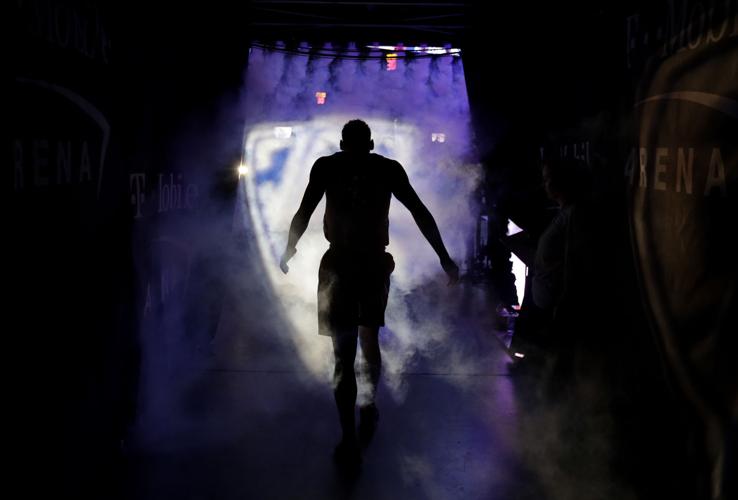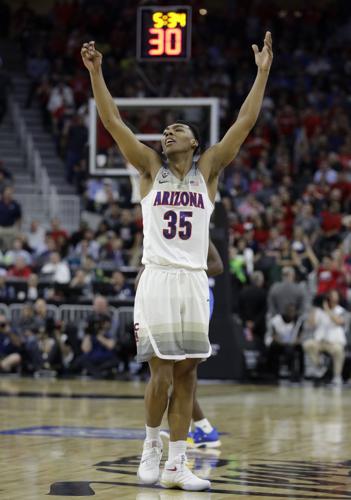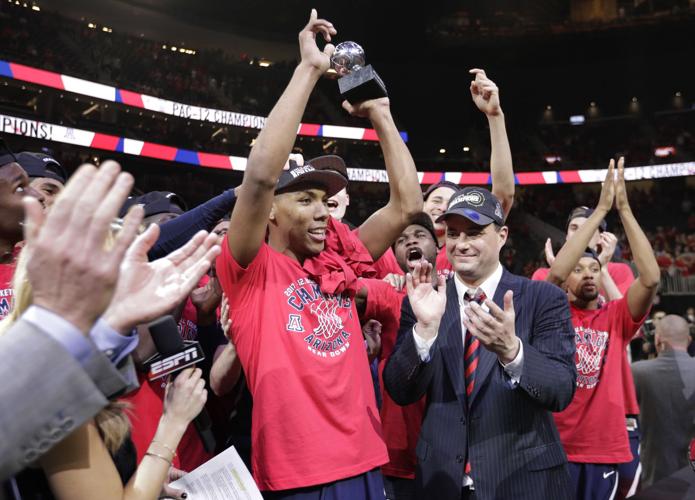This article originally published on tucson.com on March 15, 2017.
When Allonzo Trier went to the free-throw line four times late in Oregon’s near-comeback in the Pac-12 Tournament final Saturday, the pressure looked pretty intense.
Not to him.
It was fun.
It was basketball.
“I’m just proud to be playing,” he said.
Pressure for Trier this season was sitting on the bench for most of his 19-game suspension, unable to play the game he loves because of a positive PED test.
Pressure was walking around campus, deflecting his fellow students’ questions about what was going on, even as he was shielded from media inquiries and as Arizona administrators tried to protect him by saying nothing.
Trier still won’t talk much about what happened. He suffered an offseason injury in a serious car crash and has said he was given a banned substance by a “well-intentioned but misguided” person not associated with UA during the recovery process.
“That’s something I don’t really want to get into,” he said during last weekend’s Pac-12 Tournament. “It’s personal to my family. It’s undisclosed, and there’s people involved that I’m not gonna expose to the personal spotlight.”
Certainly, he knows what that feels like. Trier felt the spotlight every day since early October, when word first surfaced that he might be out, then when he was replaced by Kadeem Allen at the last minute for the Pac-12’s preseason media day.
It went on and on and on, from October to November to December and well into January.
That’s pressure.
“A lot of people don’t know what it’s like,” Trier said. “Everybody was so worried about what the issue is and why I’m out. Nobody really takes a look at what I’m actually going through, what it feels like to be me. I’m hounded every single day. You become so magnified in the media and you’re not really a normal person because you’re a high-level college basketball athlete. But at that point, I was living in a glass house. Everyone was looking at me.”
“You try to stay strong and sometimes, when you’re alone, you break down and cry. It’s a tough feeling, but you have to stay strong. You have to stay mentally tough. It’s something that made me mature a whole lot and it’s something you can’t prepare for, but I guess it happened for a reason. I’m here now and put it behind me.”
The free throws all went in. Trier made all four he took within the final 17 seconds of the Pac-12 Tournament final, giving the Wildcats an 83-80 win over the Ducks and, a day later, the conference’s top placement in the NCAA Tournament.
Trier said he never doubted the outcome.
“My preparation is what propels me through, whether it’s making a jump shot or making a 3-pointer, making plays, or stepping to the line and making big free throws,” Trier said. “I know I can step to the line and have a calmness about me because I’ve put in the time and I’m prepared.
“I should make them because I put my time in. It’s about just going in there focused and making them.”
That work ethic persevered throughout Trier’s 19-game suspension, though largely behind closed doors and closed mouths. Trier never stopped practicing with the Wildcats. He was cleared to begin traveling with the team for their Dec. 3 loss to Gonzaga in Los Angeles.
Because he wouldn’t otherwise get in much of a workout on game days, Trier would sometimes show up early before the Wildcats warmed up and go all-out in drills, mostly by himself and a ball-shagging manager or two.
That kind of work is why UA coach Sean Miller probably knew Trier would appreciate just getting to shoot those game-clinching free throws.
“One thing about Allonzo — he has kind of a poker face when he plays but, I mean, he loves the game of basketball. He loves it. Loves it,” Miller said. “He works as hard at the game as any player I’ve coached or I’ve been around, and when you work at something that hard it’s tough to not be successful.”
That’s the drawback, though. Miller said it’s hard for Type A players like that to handle tough times and, for a while, Trier’s transition back to the floor was bumpy.
Trier was finally cleared to play just before UA’s Jan. 21 game at UCLA. He came off the bench to score 12 points, grab seven rebounds and dish four assists to help the Wildcats win at Pauley Pavilion.
But while Trier scored in double figures over his next five games, he shot just 33 percent from 3-point range. His teammates struggled to adjust with him in the rotation.
“The first couple of games (with him) was tough,” Allen said. “While he was going through that situation, he practiced every day but it was difficult for the first couple of games because he was getting back into it.
“But he never got down on himself or got down on the team. Everything he did was positive, toward the team and the coaches.”
Miller played Trier more and more, then eventually moved freshman Kobi Simmons out of the starting lineup to make room for Trier on Feb. 8 against Stanford. Trier’s scoring dipped into single figures in his following two games, and he shot a combined 3 for 17 against Cal and Washington State.
While all this was happening, UA’s leading scorer during Trier’s absence, forward Lauri Markkanen, went into a stunning shooting slump. Markkanen was a 50.5-percent 3-point shooter through Jan. 29 but hit just 16.1 percent from long range over nine games through February and the Wildcats’ regular-season finale at ASU on March 4.
Trier and Markkanen caught fire together last week in the Pac-12 Tournament. Trier was named the MVP after averaging 20.7 points and making 23 of 28 free throws (82.1 percent) while Markkanen was named to the all-tournament team after averaging 20.0 points — and making 8 of 17 2-pointers (47.1 percent).
In the final against Oregon, Trier scored 23 points, had eight rebounds and took 11 trips to the foul line — making 10 free throws, including the four game-clinchers.
He had fun.
His teammates were only too happy to see him have it.
“It feels good after all the adversity he’s faced, and all the adversity we’ve faced as a team,” Allen said. “For him to get that trophy, he deserved it for all the work he put in and the people who doubted him. I’m proud that he got the trophy and excited he got the trophy, and I know the team is also.”
So what now? Trier is in his own personal midseason as UA begins tournament play Thursday in Salt Lake City against North Dakota, having played 15 games. That means he should have plenty of energy left, mixed with a sense of frustration as the season nears a close.
Even if Trier leads the Wildcats to the title game , that’s still only six more games, for a total of 21 games this season.
Those 19 games he lost to suspension will never come back.
Trier thinks about that a lot.
“I look back at a game like we played in the first five games of the season, like Cal State Bakersfield, and it was like, ‘Wow I didn’t play in the game,’ and even in the middle of the season, like at Texas A&M (Dec. 17) I didn’t play in that either,” Trier said. “It’s like, man, the season’s basically over.
“It’s a weird feeling but I’m blessed and thankful to be playing basketball. It’s tough to have it taken from me for a short period of time — kind of a helpless feeling, nothing you can do, and it’s not your fault. So to have the opportunity to play again, I’ll take it.”






